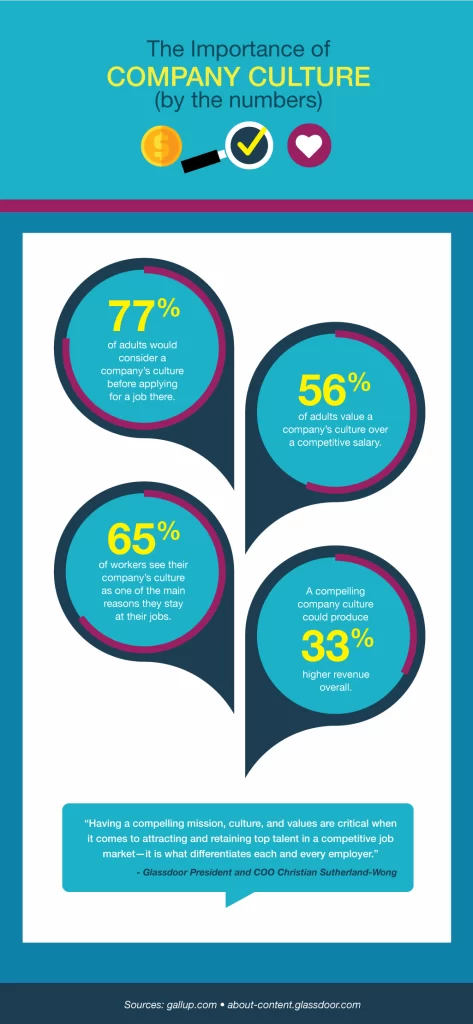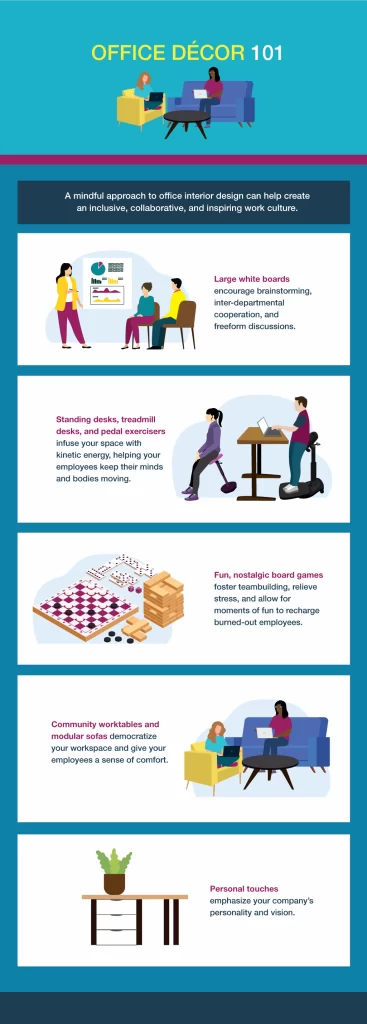Your company’s workspace can speak volumes. At just a glance, it can give clues about your productivity, your employees, your goals, and your company culture.
And while you may not initially consider the rhetoric behind your office’s interior design (a chair is just a chair, right?), office furniture and décor can help create an inclusive, collaborative, and inspiring work culture. After all, the office space you create can impact the quality of work that your employees produce.
Consider some office staples, and how they could potentially impact team interactions. Cubicles, for example, tend to offer privacy and encourage quiet work. Whereas an open, community table stimulates more informal chatter, collaboration, and conversation. Both work formats have their merits, so choosing the ideal office furniture and floorplan hinges on the exact culture team leaders wish to develop.
This is important because your work culture can generate major profits. According to a Gallup poll, employers could rake in “33 percent higher revenue by creating a culture that attracts star talent.”
In short, décor can reflect workplace values, and it is a fundamental step in building your ideal company culture.

Why is company culture important?
When people are looking for a job, they often seek out a company that aligns with their career goals as well as their personal beliefs. A recent study from Glassdoor shows that 77 percent of adults would consider a company’s culture before applying for a job there. The same study adds that 56 percent of adults value a company’s culture over a competitive salary.
Why do so many people feel this way? There are a number of potential reasons. To start, most American workers spend at least 40 hours a week at their jobs. During the week, that’s arguably more time than they spend with their families. So, naturally, people want to feel connected to and supported by the company they work for and dedicate so much time to. For example: An environmentally minded person may want to work for a company that offers a carbon-neutral workspace, while a graphic artist may steer away from a cubicle-lined office setting, and a computer fanatic may be won over by the latest and greatest in office technology.
Culture is a key factor in employee retention. The same Glassdoor study claims that 65 percent of workers see their company’s culture as one of the main reasons they stay at their jobs.
Glassdoor President and COO Christian Sutherland-Wong explains, “Having a compelling mission, culture, and values are critical when it comes to attracting and retaining top talent in a competitive job market—it is what differentiates each and every employer.”
When employees feel seen and are actively involved in your company’s mission, they are more productive. Some studies estimate that a company culture that inspires high employee engagement can see 18 percent higher revenue per employee. Indeed, company culture is a worthwhile investment with real, significant returns.

How does your office measure up?
Look around your current office space. What signals does it project to current and prospective employees? If a client or customer walked in, what would they think?
Consider the functionality of your furniture. The style. The colors. How everything is arranged.
Do your employees need more seating options for impromptu meetings and conversations? Could you positively impact the space by replacing broken, temporary, or outdated office chairs with sleek, modern options that better reflect your company’s forward-facing mission?
Would your walls inspire more creativity if they had a pop of color? In an article called “How Interior Design Impacts Your Mental Health,” Industrial Designer Calvin Dolatowski writes that viewing art “is one way professionals reduce symptoms of anxiety and depression.”
Also, be sure to consider the smaller details. For example, perhaps the notepads you have on hand for brainstorming sessions could be replaced by large white boards that promote collaboration and encourage teambuilding.
The key to finding out if your company culture aligns with your office décor is simple: ask your employees. An informal chat with various employees can elicit valuable insights. Ask them if the furniture or accessories in your workspace represent your company values, and to point out the most inspiring room in the office. You can even check with them to see if they have ever felt stifled by the environment they work in. Their answers may surprise you.
Additionally, take a look at where your employees are physically located.
In the late 1990s, when Steve Jobs was redesigning the Pixar office, he noticed that employees were siloed, and therefore physically separated, in their departments. Creatively inclined animators, left-brained computer scientists, and high-level executives worked in completely different buildings. To increase collaboration and cross-pollination of ideas, Jobs crafted large community spaces to encourage chance encounters and new working relationships. Breaking down those physical, inter-departmental barriers gave Jobs and the entire Pixar team a more egalitarian outlook, fostering collaboration, increased teamwork and—effectively—great success.
How can you match your furniture to your culture?
Expressing your company culture within your office space doesn’t have to be a daunting task. There are plenty of simple ways you can liven up your workspace to energize your company culture. Think about which values you want to emphasize, then use these examples as inspiration to match your furniture to your culture.
Creativity
If you want to emphasize company creativity, start with a lively color palette and infuse your space with kinetic energy. Standing desks, treadmill desks, and pedal exercisers will help keep your employees’ minds and bodies moving. Think of inspirational figures in your industry and hang photos of their work in your hallways. Paint a wall with chalkboard paint and allow it to be a free space for creative expression. Encourage employees to play fun, nostalgic board games to foster teambuilding and relieve stress.
Collaboration
To increase collaboration between departments and teams, consider removing cubicles in favor of large worktables, desk benches, and modular sofas. Additionally, café-style breakrooms and informal reading nooks can democratize your office and give it a more comfortable feel. Executives and new hires alike can share ideas and inspiration, leading to innovation and a revitalized workforce.
High quality
Elegant, timeless design can earn trust and speak to your employees and clients or customers on a subconscious level. If you want your office space to reflect your culture of elegance and have room in your budget for additional comfort and luxury, your team will likely be willing to go the extra mile. Executive desks and chairs will help your staff feel up to any challenge, and quality furniture will put them in the mindset of the successful people they are and want to be.
High tech
Finally, we live in a modern, computerized world, and to compete with other companies, you need to give employees what they need to get their jobs done as quickly and effectively as possible. Accentuate your furniture choices with conveniences such as docking stations, high-resolution monitors, digital whiteboards, and digitized building management systems. Your employees will thank you for embracing the wonders of technology, and your clients will trust you to be the cutting edge.

Conclusion
The world’s most successful companies prioritize company culture through interesting, engaging office spaces. Educated design will elevate your office culture. It’s not just an aesthetic choice; it’s potentially a fiscal imperative. As confirmed by a 2020 article in the MIT Sloan Management Review, the marriage of employer behavior with office culture “allows companies to differentiate themselves from competitors, build trust with stakeholders, increase brand equity, and attract great talent.”
For more articles in the same niche, you can visit his blog for more details.
Be First to Comment